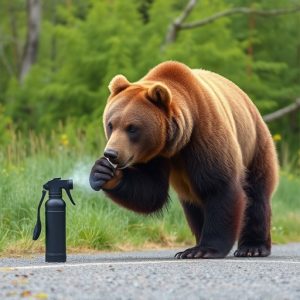Maximizing Wind Direction Bear Spray Safety for Outdoor Protection
Understanding wind direction is key for effective use of bear spray as a safety measure against aggr…….
Understanding wind direction is key for effective use of bear spray as a safety measure against aggressive encounters. By positioning yourself and spraying into the wind, you maximize its impact on deterring bears. Regularly checking weather forecasts for wind patterns, carrying bear spray correctly, and learning proper application techniques significantly enhance outdoor safety in bear country.
In areas inhabited by aggressive bears, understanding their behavior and implementing effective outdoor safety measures is crucial. This article explores comprehensive strategies for protection against these formidable creatures, focusing on wind direction as a key factor in bear spray safety. Learn how to choose the right bear spray and master application techniques. Additionally, discover other essential precautions to take when venturing into bear country, ensuring your safety and minimizing conflicts with these wild animals.
- Understanding Bear Behavior and Their Sense of Smell
- Wind Direction: A Crucial Factor in Bear Spray Safety
- Choosing the Right Bear Spray and Proper Application Techniques
- Additional Measures for Outdoor Protection Against Aggressive Bears
Understanding Bear Behavior and Their Sense of Smell
Understanding bear behavior is a crucial step in ensuring safety when venturing into their habitat, especially in areas known for aggressive bear encounters. Bears possess an exceptional sense of smell, which plays a significant role in their interaction with their environment and potential threats. They can detect scents from great distances, often using this ability to locate food sources or identify potential dangers. Knowing that bears rely heavily on their olfaction, it’s essential to be mindful of wind direction when carrying bear spray—a common safety measure. By being conscious of the wind’s movement, you can ensure that your bear spray is effective and strategically aimed, as a strong breeze could potentially blow the spray back towards you or reduce its impact on the target bear.
Bears are naturally cautious animals and often avoid human interaction if possible. However, certain behaviors like defending food sources, protecting their cubs, or feeling threatened can prompt an aggressive response. Familiarizing yourself with these triggers and being prepared to respond calmly during a close encounter is key. Bear spray, when used correctly, can serve as a powerful deterrent, creating a temporary barrier between you and the bear by obscuring their sense of smell.
Wind Direction: A Crucial Factor in Bear Spray Safety
Understanding wind direction is a critical component of ensuring bear spray safety during outdoor adventures in bear country. Bear spray, a popular deterrent for unexpected encounters, functions best when applied against the wind. Using it into the face or fur of an approaching bear provides the most effective barrier. However, if you’re spraying into the wind, the chemical agents may not reach the bear effectively, leaving you vulnerable to an attack.
Knowing which way the wind is blowing allows adventurers to position themselves and apply bear spray accordingly. When planning a hike or camp in areas known for bear activity, check weather forecasts for wind patterns. Staying upwind of potential bear habitats increases safety during encounters. Always carry bear spray strategically, with the nozzle facing backward so it’s ready to be deployed against the wind if needed.
Choosing the Right Bear Spray and Proper Application Techniques
When considering outdoor protection against aggressive bears, choosing the right bear spray and mastering proper application techniques are paramount. Key to effective use is understanding wind direction – always spray away from yourself and potential targets, as the chemical can be harmful if inhaled or gets into eyes. Aim for the bear’s face, moving from downwind to upwind, in a wide arc. This ensures maximum impact while minimizing backsplash.
Proper application involves a firm but controlled squeeze, starting at a distance of about 20-30 feet (6-9 meters) and continuing until the bear is deterred or retreats. It’s crucial to practice this technique beforehand, ensuring you’re familiar with the spray’s range and pattern. Regular maintenance and checking expiration dates are also essential for safety, as spray can degrade over time.
Additional Measures for Outdoor Protection Against Aggressive Bears
When dealing with potential aggressive bears, it’s crucial to go beyond the basics and implement additional safety measures. One effective tool is understanding and utilizing the wind direction. Always carry bear spray, ensuring it’s within easy reach and properly trained on how to use it effectively. When encountering a bear, spray in the direction the wind is blowing—this will create a barrier between you and the bear, potentially deterring an attack.
Regularly checking weather conditions and being aware of prevailing wind patterns can offer valuable insights into managing bear encounters. Additionally, wearing loud clothing or carrying noise makers can help ward off bears by announcing your presence, as bears often avoid areas with human-like sounds. These precautions, combined with proper knowledge and behavior around bears, significantly enhance outdoor safety in bear country.
Understanding bear behavior, leveraging wind direction for bear spray safety, choosing effective bear spray, and mastering application techniques are key components of outdoor protection against aggressive bears. By combining these strategies with additional measures, such as making noise while hiking and securing food properly, you can significantly reduce risks during your outdoor adventures in bear country. Remember, knowledge and preparation are your best defenses.


